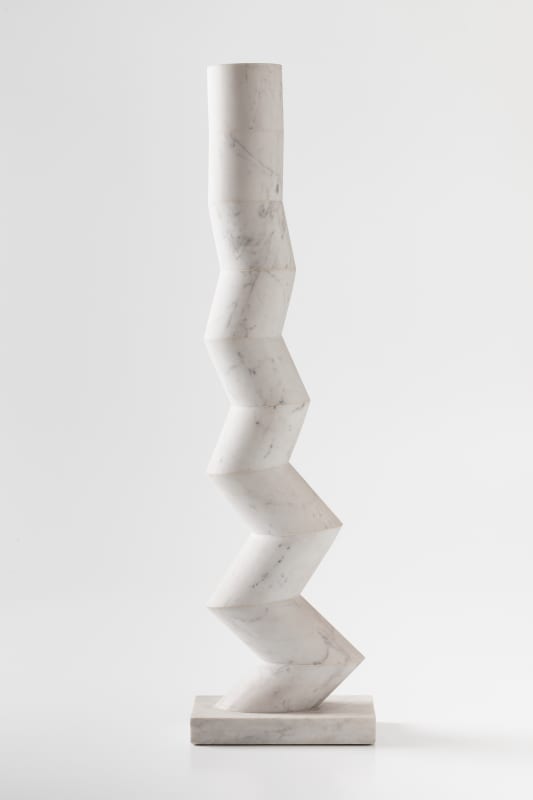Sérgio Camargo (Rio de Janeiro, RJ, 1930 - idem, 1990). Sculptor. Considered one of the most original Brazilian artists linked to the constructive approach, he stands out for exploring the limits of form by making audacious cuts in the materials, in a procedure he calls "empirical geometry".
Although he has had contact with constructive works since the beginning of his career, Sérgio Camargo develops an independent and personal work, without affiliating himself to any group or movement. For two years (1946-1948) he studied at Academia Altamira in Buenos Aires, where he was mentored by Argentine artists Emilio Pettoruti (1892-1971) and Lucio Fontana (1899-1968). There he became interested in constructivism in Argentina. He left for Paris in 1948, where he studied the work of Romanian sculptor Constantin Brancusi (1876-1957) and took a philosophy course at the Sorbonne. During this period, he became familiar with the sculptures of Georges Vantongerloo (1886-1965) and Henri Laurens (1885-1954).
Back in Brazil, he produced his first figurative bronze sculptures in 1954, in which his concern with the volume of the works and the power of the cuts that organize the masses are already evident-fundamental qualities of his later works. Once again in Paris (1961), he attended the Sociology of Art course taught by Pierre Francastel (1905-1970), at the École Pratique des Hautes Études, and experimented with plaster, sand and fabric, creating irregular and shapeless structures.
Beginning in 1963, he produced the series Relevos, which he worked on proficiently for about ten years. The operation is almost always the same: to arrange white wooden cylinders of various sizes, cut at various angles, on a flat surface also white and made of wood. The challenge lies in creating compositions in which the original geometric form-cylinders or parallelepipeds-is systematically broken and rearticulated to establish a new arrangement, non-reversible to the starting point. At this instant, the difference between Camargo's method and the procedure of historical constructivism becomes evident. Even incorporating the coherence of a systematic attitude and geometric exactness, his work opens to the unforeseen; it embraces, in critic Ronaldo Brito's interpretation (1949), order and the madness of order. The reliefs are well-received in Europe, and Camargo develops a successful international career.
In the mid-1960s, the artist began to experiment with carrara marble in some pieces. He created several works for public spaces, including: the structural wall of the Palace of the Ministry of Foreign Affairs in Brasilia; the Triptych of the Bank of Brazil in New York; the column Homenagem a Brancusi, for the Faculty of Medicine in Bourdeaux, France; a sculpture in Praça da Sé, in São Paulo; and a monument for the Catacumba Park in Rio de Janeiro.
It was only in the 1970s that he began to use marble almost exclusively in decisively sculptural works, in a natural passage from the reliefs known as "trombas" to floor pieces. On the one hand, this material, with strong roots in the sculptural tradition, accentuates the permanence and stability of the works. On the other hand, the smooth and uniform surface of polished marble reacts more effectively to the effects of light, intensifying the dynamic and transitory aspect of the set.
Camargo returned to Rio de Janeiro in 1974, but maintained a studio in Massa Carrara, Italy, until the end of his life. With elongated pieces in Noir Belge stone, produced in the 1980s, the artist radically experiments with the limits of form by making increasingly sharp cuts, threatening the physical integrity of the material. He reaches the extreme point of possible coexistence between order and its dissolution. According to critics, these works add a certain dramatic connotation to Sérgio Camargo's unique constructivism.
The possibility of combining, in a coherent and concise manner, a restricted number of geometric volumes (cylinders, cubes, rectangles), without being accountable to a didactic rationality, gives Camargo's method a permanent experimental character throughout his work. Such experimentalism, with all due differences, places him alongside artists such as Lygia Clark (1920-1988), Mira Schendel (1919-1988), and Hélio Oiticica (1937-1980). Even guided by the constructive principle of integral coherence and lucidity, Camargo's work does not abandon the páthos of adventure characteristic of modern lyricism, as Ronaldo Brito also observes.
In a period in which one believes in the exhaustion of innovation and in which one defends the overcoming of the modern legacy, Sérgio Camargo inaugurates a trajectory in which the conflicting, but always attentive, relationship with a pre-existing tradition generates an innovative and singular production.
SÉRGIO Camargo. In: ENCICLOPÉDIA Itaú Cultural de Arte e Cultura Brasileiras. São Paulo: Itaú Cultural, 2021. Available at: <http://enciclopedia.itaucultural.org.br/pessoa8759/sergio-camargo>. Accessed on: June 25, 2021. Encyclopedia entry. ISBN: 978-85-7979-060-7

